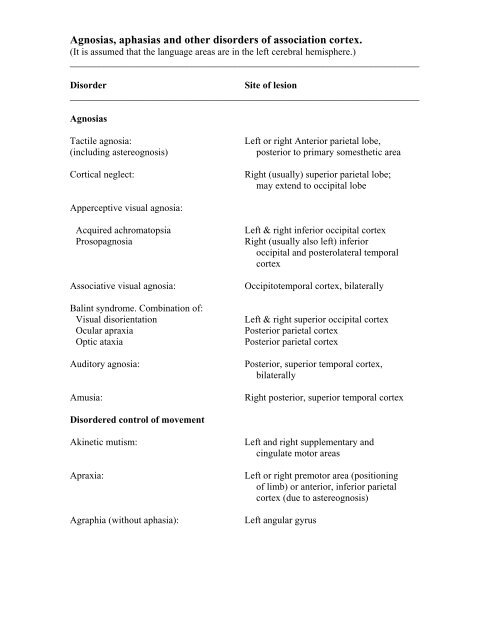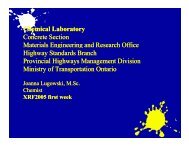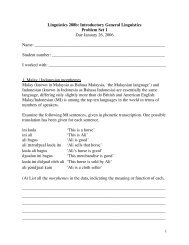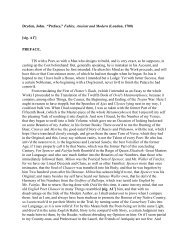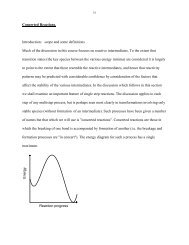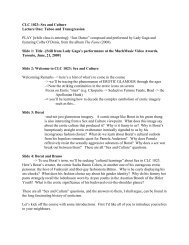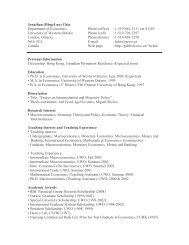Agnosias, aphasias and other disorders of association ... - Instruct Uwo
Agnosias, aphasias and other disorders of association ... - Instruct Uwo
Agnosias, aphasias and other disorders of association ... - Instruct Uwo
Create successful ePaper yourself
Turn your PDF publications into a flip-book with our unique Google optimized e-Paper software.
<strong>Agnosias</strong>, <strong>aphasias</strong> <strong>and</strong> <strong>other</strong> <strong>disorders</strong> <strong>of</strong> <strong>association</strong> cortex.<br />
(It is assumed that the language areas are in the left cerebral hemisphere.)<br />
________________________________________________________________________<br />
Disorder<br />
Site <strong>of</strong> lesion<br />
________________________________________________________________________<br />
<strong>Agnosias</strong><br />
Tactile agnosia:<br />
(including astereognosis)<br />
Cortical neglect:<br />
Left or right Anterior parietal lobe,<br />
posterior to primary somesthetic area<br />
Right (usually) superior parietal lobe;<br />
may extend to occipital lobe<br />
Apperceptive visual agnosia:<br />
Acquired achromatopsia<br />
Prosopagnosia<br />
Associative visual agnosia:<br />
Balint syndrome. Combination <strong>of</strong>:<br />
Visual disorientation<br />
Ocular apraxia<br />
Optic ataxia<br />
Auditory agnosia:<br />
Amusia:<br />
Left & right inferior occipital cortex<br />
Right (usually also left) inferior<br />
occipital <strong>and</strong> posterolateral temporal<br />
cortex<br />
Occipitotemporal cortex, bilaterally<br />
Left & right superior occipital cortex<br />
Posterior parietal cortex<br />
Posterior parietal cortex<br />
Posterior, superior temporal cortex,<br />
bilaterally<br />
Right posterior, superior temporal cortex<br />
Disordered control <strong>of</strong> movement<br />
Akinetic mutism:<br />
Apraxia:<br />
Agraphia (without aphasia):<br />
Left <strong>and</strong> right supplementary <strong>and</strong><br />
cingulate motor areas<br />
Left or right premotor area (positioning<br />
<strong>of</strong> limb) or anterior, inferior parietal<br />
cortex (due to astereognosis)<br />
Left angular gyrus
Behavioral <strong>and</strong> affective changes<br />
Acquired sociopathy:<br />
Anosognosia (<strong>and</strong><br />
anosodiaphoria):<br />
Depression:<br />
Ventromedial prefrontal cortex, usually<br />
bilaterally<br />
Either right inferior parietal cortex,<br />
or right inferior medial prefrontal<br />
cortex<br />
Left prefrontal cortex more <strong>of</strong>ten than<br />
<strong>other</strong> localized lesions<br />
Speech <strong>and</strong> language <strong>disorders</strong><br />
Receptive (Wernicke's) aphasia:<br />
Anomic aphasia:<br />
Transcortical aphasia:<br />
Receptive type:<br />
Expressive type:<br />
Alexia with agraphia<br />
Pure alexia (without agraphia):<br />
Expressive (Broca's) aphasia:<br />
Global aphasia:<br />
Conduction aphasia:<br />
Subcortical aphasia:<br />
Left posterior, superior temporal cortex<br />
(Wernicke's area)<br />
Left parietal lobe, posterior to<br />
Wernicke's area<br />
Left middle temporal gyrus, inferior to<br />
Wernicke's area<br />
Left frontal lobe, anterior to Broca's area<br />
Wernicke’s area <strong>and</strong> left angular gyrus<br />
Left occipital lobe <strong>and</strong> associated<br />
commissural fibers either in the<br />
underlying white matter or in the<br />
splenium <strong>of</strong> the corpus callosum<br />
Left frontal operculum (Broca's area)<br />
Whole left perisylvian area (frontal,<br />
parietal & temporal opercula)<br />
Left inferior parietal lobe (supramarginal<br />
gyrus) <strong>and</strong> underlying arcuate fasciculus<br />
Head <strong>of</strong> left caudate nucleus<br />
Aprosodia:<br />
Right perisylvian area (frontal, parietal<br />
& temporal opercula)<br />
________________________________________________________________________<br />
From Kiernan JA Barr’s The Human Nervous System, 8 th ed. (Table 15-1)<br />
Copyright©2005 Lippincott, Williams & Wilkins, Baltimore & Philadelphia


